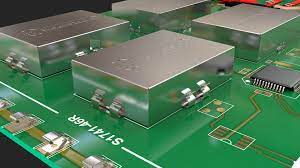Every company in the electronics industry is now subject to CE/EMI regulations. The use of electronic devices, as well as exposure to a wide range of frequencies, is increasing. Radiation and immunity must be considered in the early stages of new product development. In many cases, EMI problems cannot be solved solely at the PCB level; enclosures and cables must also be shielded.
Legal requirements and other reasons to seek protection
Shielding is a quick way to meet legal requirements for electromagnetic interference prevention. Shielding solutions are cost-effective because they do not necessitate time-consuming development before meeting EMI requirements. Shielding is commonly used in enclosures to isolate electrical devices from external influences, and in cables to isolate wires from the environment through which the cable runs. If a company wants to launch a product quickly but the emissions exceed the prescribed limits, easy-to-apply shieldings are a common solution. Shieldings are useful for appliances with high radiation or sensitivity levels, as well as for products where these levels are unknown in advance, such as modular enclosures. When dealing with sensitive measurements that can be affected by ambient fields, shieldings are used. Shielding is clearly a common phenomenon and a requirement in the electronics industry to meet today’s emission standards.
Aspects to consider in the design of shielded enclosures:
- Materials and corrosive environments
Galvanized steel and aluminium are the least expensive materials for electromagnetic shielding. When used in a corrosive environment, it is preferable to avoid contact with stainless steel, brass, or an aluminium chromate layer.
- The enclosure material’s thickness
A thickness of 0.1 mm should be sufficient to effectively shield against frequencies above 1 MHz. When dealing with eddy currents at lower frequencies, such as 30 kHz and less, it is necessary to use materials with good magnetic conductivity as well as electric conductivity, and thicker material may be required.
- Avoid openings in enclosures.
It is critical to avoid gaps in the enclosure, especially at frequencies above 5 kHz. High frequencies in the 100 MHz to 40 GHz range are extremely sensitive to small gaps in the enclosure. The higher the frequency, the greater the importance of preventing holes and gaps in the shield. Soft and flexible gaskets come into play here. The gasket should not only be highly conductive, but it should also maintain continuous electrical contact with the enclosure while requiring little compression force.
- Dimensions of mountings, hinges, and locks
Specialists will be happy to receive a drawing preferably including dimensions, quantity needed, enclosure materials, and indication of stiffness of enclosure material to give you an idea of what type of gasket would be suitable for your application. They have extensive experience with a wide range of shielding applications and frequently see more than 50 designs per day. Specialists can assist you in selecting the best type of gasket for any application.
- Clock speed increases
Electromagnetic interference (EMI) is becoming more common as clock speeds in today’s PCs and workstations increase.
This has compelled regulatory agencies to impose limits on electromagnetic radiation emitted by PCs and any electronic device that uses clocks and emits emissions.
- Analysis of Electromagnetic Interference
Electromagnetic radiation is produced by almost any electrical transition with sharp edges, such as clocks, data, addresses, and control. Clock speeds have increased in tandem with performance requirements. As it became more difficult to meet set up and hold time, the transition edge, or slew rate in engineering terms, became faster and faster.
Clocks are no longer fed to just one or two circuit board devices. Rather, they are dispersed throughout the circuit board. Increased memory requirements, as well as other loads on the clock lines, have also contributed significantly to electromagnetic radiation.
Shielding is the most common method for reducing EMI.


























